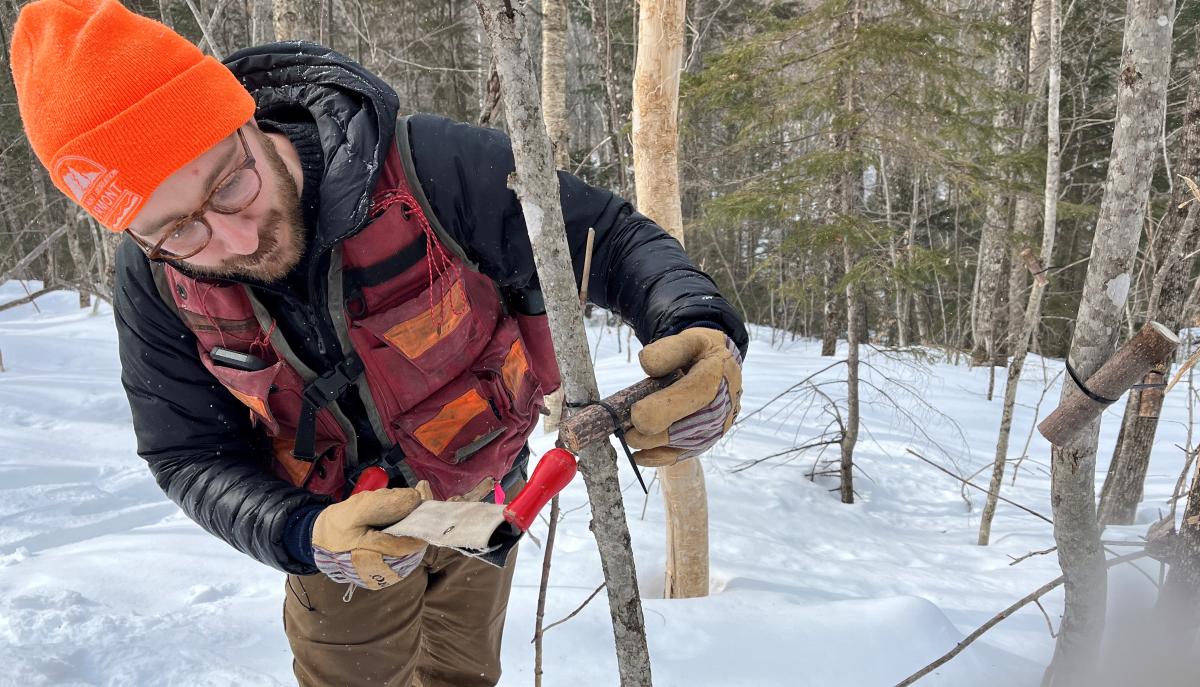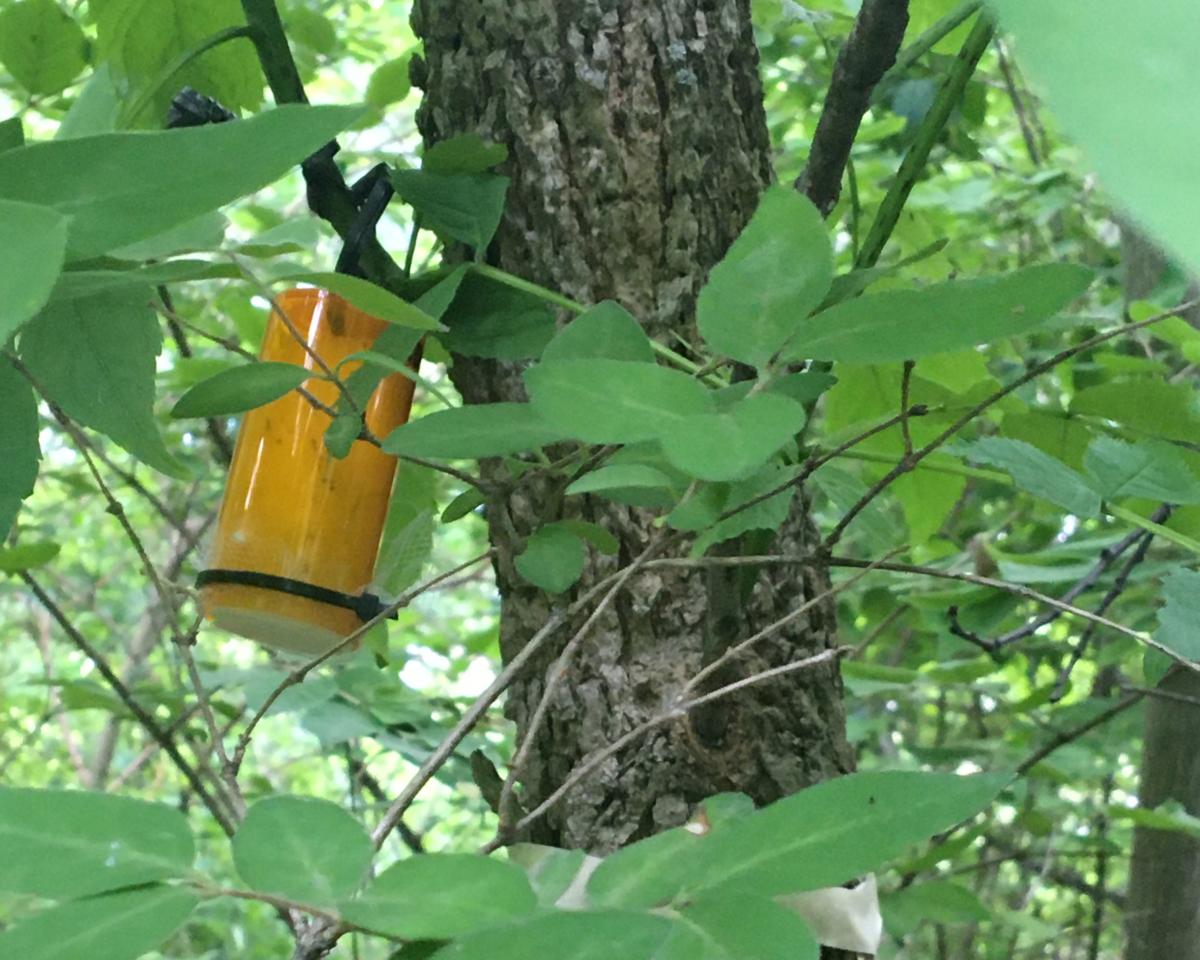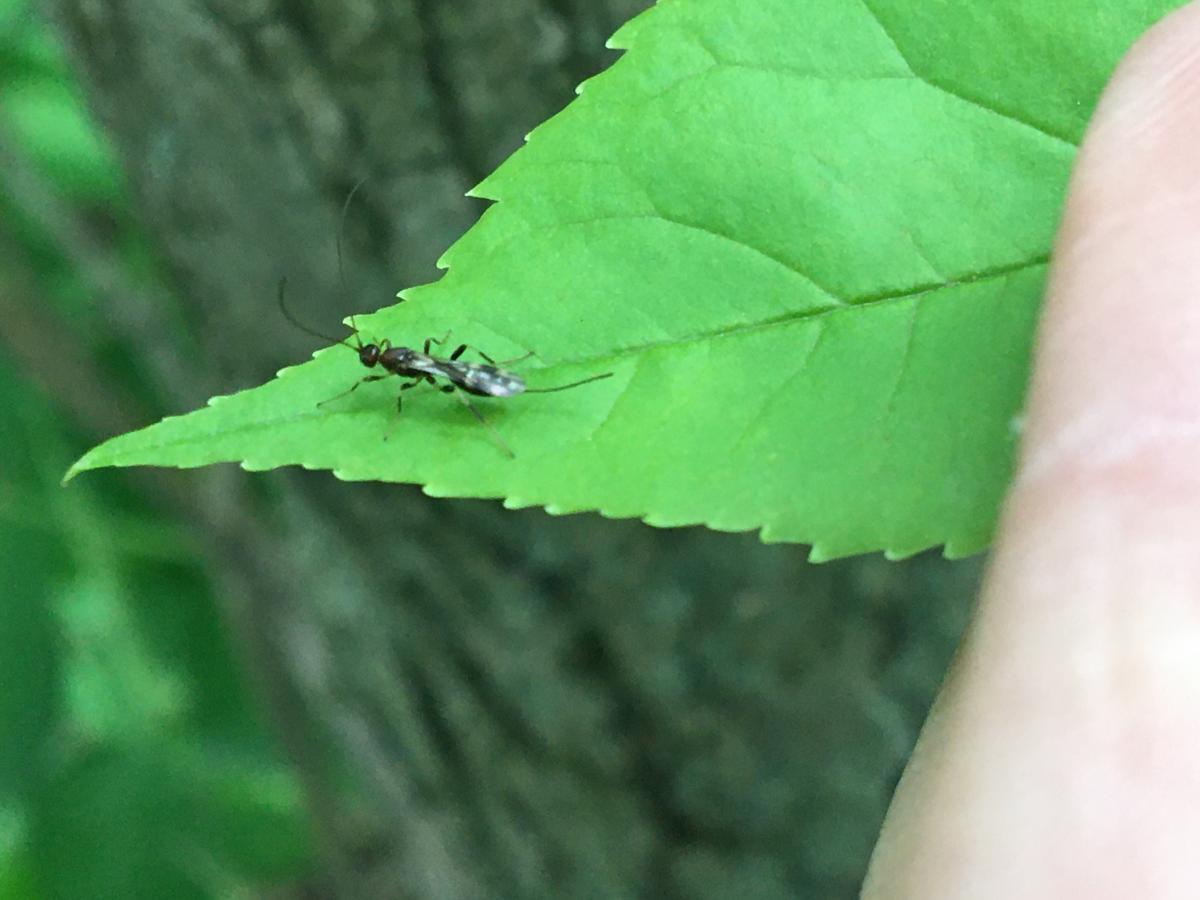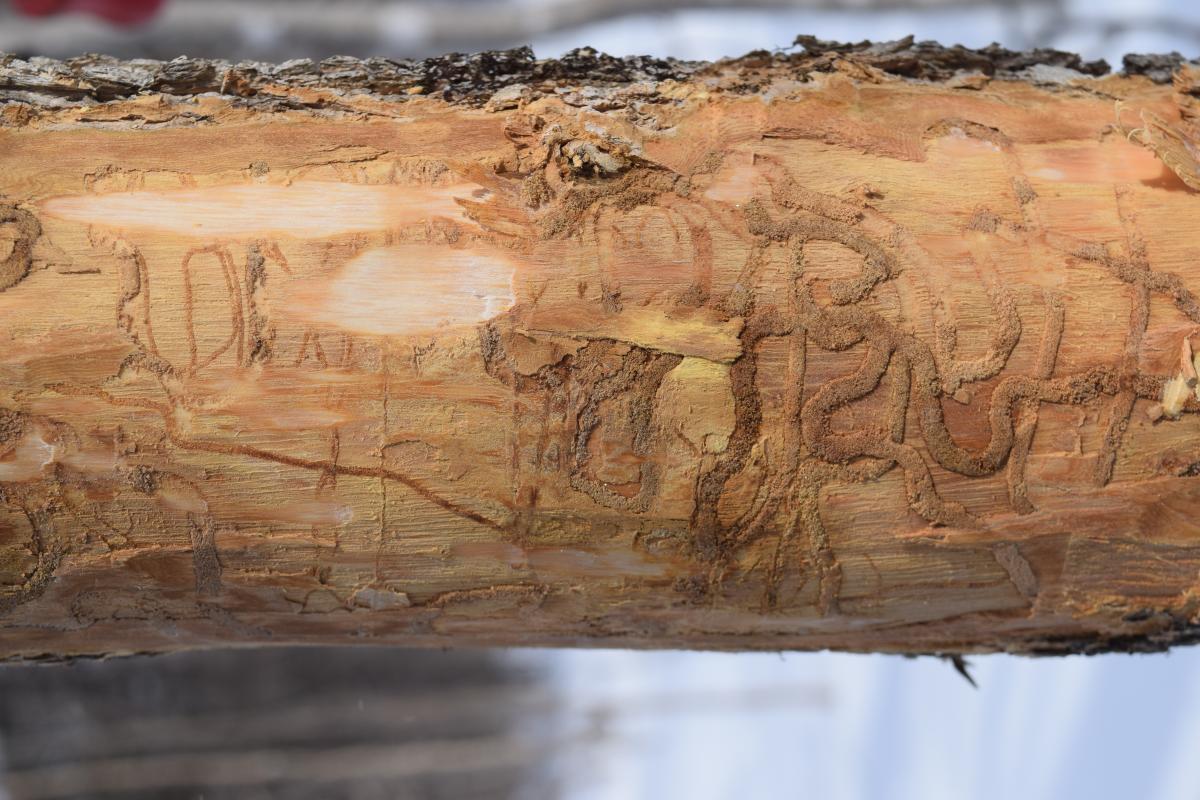To walk through the woods on a bright winter day in Vermont, one needs snowshoes, warm clothes, and an endless ability to look up. The ground cover is hidden beneath a winter’s worth of ice and snow but the canopy is open to the sky, affording views to the branches against a blue and cloudless backdrop. In LR Jones State Forest in Plainfield, Vermont, a small group of foresters look up for damage to native ash trees, injury caused not by wind or ice but by woodpeckers in search of an exotic meal: emerald ash borers.
“It’s spooky,” concurred State Forest Health Specialist Jon Cherico. “Finding EAB out here is not where we thought we would start this work.”
LR Jones State Forest boasts many distinctions; not only is it the first and oldest designated state forest in Vermont, but now it hosts one of the state’s most widespread stands of ash trees infested with emerald ash borers (Agrilus planipennis Fairmaire, commonly called EAB). The beetle is a non-native and invasive forest pest unintentionally brought to Detroit, Michigan, and Windsor, Ontario, in the 1990s. First detected and confirmed in Vermont in February of 2018 in Orange, EAB was likely introduced to this state forest at least six years ago. Its point of entry and method of transportation remain unknown.
Standing in the quiet woods, State Lands Forester Dan Singleton recounts how, during a routine tree marking in early 2020 ahead of a planned forest management project, he noticed both black and white ash trees (Fraxinus nigra and Fraxinus americana) exhibiting the classic signs of emerald ash borer infestation – woodpecker-flecked stems, split bark, and even segments of bark peeling and sloughing from trees. Deep in the forest, he was surprised to find the beetle established among native trees. “It’s spooky,” concurred State Forest Health Specialist Jon Cherico. “Finding EAB out here is not where we thought we would start this work.” The prevalence of campgrounds, trailheads, and private camps may have provided some cautionary warnings, as would the knowledge that some EAB pioneers (i.e., the bravest flyers) can be found far from initial infestation sites. But typically, foresters and arborists find the earliest signs of regional infestations in ash trees near populated areas due to the ease with which these ash trees can be monitored, and the insect detected.
Although an adult beetle will fly only 1-2 miles per year, the quick and pockmarked spread of EAB throughout the eastern United States and Canada tells a classic tale of people-assisted movement, whether through transportation of ash firewood, packaging material, pallets, lumber, or nursery stock. “Something is happening,” said State Watershed Forester David Wilcox. “We’re finding ash trees that were healthy two years ago but now show obvious signs of EAB. Right now, we’re in hot spots that aren’t connected. But it’s coming, unfortunately.” By the time Vermont confirmed the presence of EAB, 34 other states and two provinces had already launched EAB mitigation and ash tree management action plans including strategies such as ash tree inventory, treatment of ash trees with insecticide, harvest of select ash trees, and, in urban areas, ash tree removal and replanting of other tree species.
On the heels of such management actions were controlled releases of parasitic wasps, specifically three species of highly researched and stingless wasps that lay their eggs in either the larvae or eggs of emerald ash borers. The hatched young of these wasps feed on the host EAB, ultimately killing it before it hatches or pupates into an adult beetle. The wasps parasitize only emerald ash borers or other species of Agrilus beetles (none of which are native to North America), do not sting or harm other insects or animals (including us), can survive cold weather by overwintering successfully in EAB eggs or larvae, and undergo multiple life cycles per season, establishing permanent populations where EAB is present.
Bred in a USDA EAB Biological Control Facility in Brighton, Michigan, wasps are shipped overnight and provided at no cost to state cooperators and researchers, but not to landowners or members of the general public.
But rearing, releasing, and monitoring the wasps for their efficacy in reducing the impact of emerald ash borers is not for the casual tree enthusiast or backyard forester. Bred in a USDA EAB Biological Control Facility in Brighton, Michigan, wasps are shipped overnight and provided at no cost to state cooperators and researchers, but not to landowners or members of the general public. Moreover, biocontrol of EAB using wasps is not an acute solution to the introduction and spread of an invasive insect; their release is a landscape-level approach to control, but not eliminate, the regional population of EAB. Biocontrol release sites must already host EAB, ideally at low-to-moderate levels, exhibit a significant number of ash trees of many age and size classes, and measure a minimum of 40 contiguous acres of forest necessary to sustain a wasp population.
Cherico grips a small bolt of ash wood strung unceremoniously to a living ash tree and recounts his previous visits to release the wasps just months after the EAB infestation was discovered in LR Jones State Forest. Each bolt hosts parasitic wasps that are shipped overnight from the rearing facility in Michigan, raced into the forest by Cherico and State Forest Health Specialist Josh Halman, and installed on designated and inventoried ash trees within one acre of forest. In three waves separated by two weeks each, Cherico released just under 1,000 of Vermont’s first species of parasitic wasp pupae, Tetrastichus plannipenisi. Later that fall, he released a further 3,500 wasp pupae in the same region on an identical schedule. In tandem, Halman was travelling to a state-led sister site in South Hero, implementing a similar biocontrol release program among infested ash there.
Tetrastichus plannipenisi is one of several approved wasp species used for biocontrol in North America. A second wasp species, Oobius agrili, parasitizes EAB eggs, not larvae, and can also withstand the low temperatures of a Vermont winter. So does a third species, Spathius galinae. With a longer ovipositor than Tetrastichus plannipenisi, Spathius may also parasitize EAB larvae in large ash with thicker bark.
In the spring and fall of 2021, Cherico and Halman released approximately 2,600 pupae and adult wasps of all three species from ash bolts and small pill bottles hung from ash trees. In 2022, further releases of Spathius galinae and Oobius agrilii will complete the prescribed cycle of biocontrol releases. Finally, in 2023, State foresters will begin to monitor the forest for wasp survivorship using yellow pan traps containing diluted propylene-glycol that capture and funnel wasps into a collection vial. The short-term hope is that adult wasps will lay eggs in EAB larvae in time to overwinter, establishing a self-sustaining population within two years.
In concert with biocontrol efforts, foresters are also monitoring for lingering ash, or native ash trees that exhibit tolerance or even resistance to EAB infestation. The Agency of Natural Resources is considering preservation of ash trees using trunk-injected, systemic insecticides. At present, the Agency has not treated any ash trees on state land with insecticide but does not preclude the possibility of doing so with correct permissions, monitoring, and understanding of the ecological benefits and risks and financial commitment.
Biocontrol programs, while innovative and effective, will not preclude the death of many mature ash; instead, they may offer the next generation of ash trees a fighting chance.
Vermont is several years away from reaching the peak of emerald ash borer infestation and the ensuing wave of widespread ash tree mortality. There is still time to slow the spread of the beetle through responsible management of ash trees and wood, treatment of high-value ash trees, and continued study of both biocontrol efforts and breeding of EAB-resistant ash trees. But mass mortality of ash trees, a scenario witnessed already in neighboring states and provinces, is forthcoming within decades, and those with their eyes on the trees will see a marked change in the forest. Biocontrol programs, while innovative and effective, will not preclude the death of many mature ash; instead, they may offer the next generation of ash trees a fighting chance.
EAB Awareness Week. Vermont, along with the rest of the country, will recognize National Emerald Ash Borer Awareness Week May 22-28. The Vermont Invasives’ Emerald Ash Borer Awareness Week Toolkit provides posters, videos, sample social media posts, and other tools; resources for educators; information on ash tree identification; and guidelines for hosting a neighborhood ash tree walk or tree tagging event.
Learn more about emerald ash borers in Vermont at VTinvasives.org/eab and municipal EAB preparedness at vtcommunityforestry.org/eab.
Adult Spathius galinae wasp, one of three stingless wasp species released in June 2021 to act as a biocontrol of emerald ash borers. Photo credit: Judy Rosovksy.

State Forest Health Specialist Jon Cherico checks on a bolt of ash wood used to deliver certain species of stingless wasps to LR Jones State Forest where they may parasitize the invasive forest pest emerald ash borer. Photo credit: Joanne Garton.

Sometimes called an “Oobinator”, a vial of Oobius agrili hangs in an ash tree in June of 2021 in South Hero, Vermont. Photo credit: Judy Rosovsky.
S-shaped tunnels (called galleries) formed by emerald ash borer larvae feeding just below the bark of an ash tree. Photo credit: Elise Schadler.

